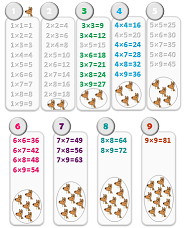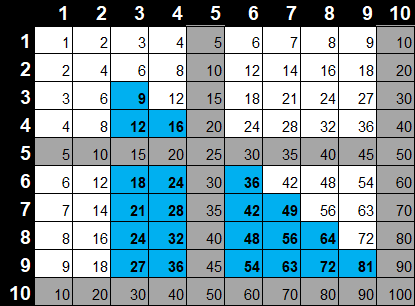What are times tables?
Investigation into the most practised maths skill

A large part of learning times tables is about learning a way to organise multiplication facts. Often this is actually done with a list, not a table. Actually learning these facts as a table is much more effective. One of the main benefits is that there are less facts to learn. The commutative property of multiplication means that 3 x 5 is both in the 3 times table and the 5 times table.
Times table lists are very common. There are posters highlighting all the times table equations up to the 12 times table sometimes in lots of classrooms and homes around the country. They are usually printed in student planners or on exercise books. I even have pencils that have them printed on!
 We are not usually too worried about getting students to learn the 1, 2, 5 or 10 times table either. This leaves 21 multiplication facts to learn. Here is the Kangaroo Maths' version of times table lists (as we call multiplication facts organised in a list) which highlights this idea really well. They cross out facts that you don't need to learn again.
We are not usually too worried about getting students to learn the 1, 2, 5 or 10 times table either. This leaves 21 multiplication facts to learn. Here is the Kangaroo Maths' version of times table lists (as we call multiplication facts organised in a list) which highlights this idea really well. They cross out facts that you don't need to learn again.
 Here is that same concept in a tabulated format. Here the important facts to remember are the numbers coloured blue. All the others don't take too much effort to learn (a good discussion to have is why the others are easier. It will be a different reason for different groups of numbers but it's worth bringing up)
Here is that same concept in a tabulated format. Here the important facts to remember are the numbers coloured blue. All the others don't take too much effort to learn (a good discussion to have is why the others are easier. It will be a different reason for different groups of numbers but it's worth bringing up)
The table is not as clear a format as the list. You can't see the multiplication equations as you can in the list. You have to learn how to use it. It is really well worth the investment to learn though. It is a structure that we use in so many ways.
The advantages of the table format go deep. As well as offering a natural model for commutativity, it lends itself to a broader view of multiplication. Lists reinforce the idea that multiplication is repeated addition. While this might be a good way to be introduced to multiplication (I'm not sure that it is. There are reasons to start teaching multiplication before addition which will be discussed in a later post), it is a limited model and could be part of the reason that proportional or multiplicative thinking is a problem within mathematics education. Tables are a far richer way of developing the concept. But even tables have their limits. What other structures could we use to organise multiplication facts?
Webs
Spider diagrams or mind maps have become a very popular way to organise information. The idea of networks, the Internet, tube and bus maps etc. all have helped us to become more familiar with this structure. They are more closely linked to our natural way of organising information and offer advantages to both lists and tables with flexibility and visual appeal being among them. What they specialise in is highlighting relationships which is an important part of understanding numbers.
How would we organise multiplication facts using a tree-like structure? Prime Colours is a particularly useful tool to start to see this. A tree structure relies on knowing which numbers are naturally connected. We'll get into how to do this in another post but here is an example of the colours organised in a web or tree. See if you can work out what criteria is needed to link cards and then create some of the links I've missed out. As you explore, you might start to see a grid taking shape. It can start to look like a grid. Does it have any advantages over our usual grid? Experiment with these links and see if you can find something out about this structure. Start small and look for how the cards get connected together. Let us know if you have any comments or preferences regarding tables, lists or webs in multiplication.
